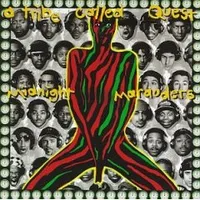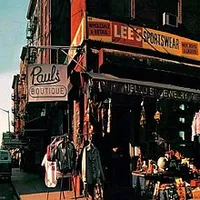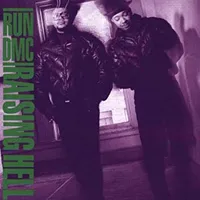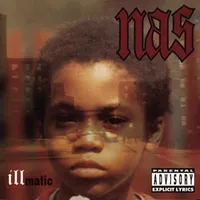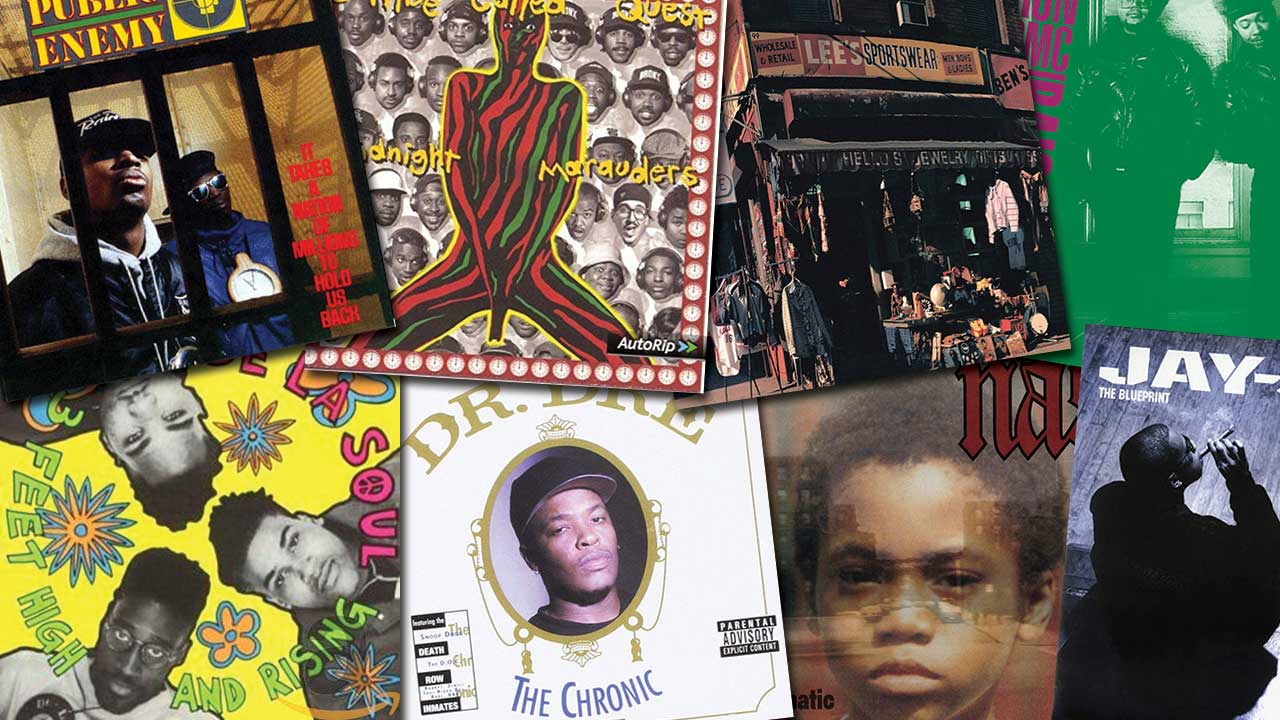
All albums were not made equal. Just as there are albums that benefit from the laboratory-tuned precision of digital formats or those which want to be heard solely through superior quality headphones, there are also those which just need the glorious, fuzzy warmth of vinyl to perform at their best.
Hip hop is one of the genres which benefits most. With its origins in the twin reord player set-ups found at New York block parties, it follows that hip hop music is at its prime when it comes courtesy of vinyl's rich grooves.
But with so many classic albums being repressed and reissued to keep up with vinyl's growing popularity, it can feel overwhelming trying to work out where to start. Here, we assemble the 10 essential hip hop albums every record collector should own. Make sure you have one of the best record players to play them on too, or one of the best budget turntables if you have a smaller budget.
- Want some new wax? Explore the best Black Friday vinyl deals
- Best headphones for music: supercharge your listening
- Best headphones for vinyl: get the most from your records
- The 15 best classic rock albums to own on vinyl
- 9 cool vinyl record storage ideas
- How to clean vinyl records, deal with scratches and more
- Does 180g vinyl sound better?

A Tribe Called Quest - Midnight Marauders (Jive, 1993)
A Tribe Called Quest had made an impact as early as 1990 with their single Can I Kick It?, which sampled a diverse range of sources such as Lou Reed’s Walk On The Wild Side and the British children’s TV series SuperTed. By 1993, and their third album Midnight Marauders, the Tribe had refined their music still further, including explicit social commentary such as Steve Biko (Stir It Up), recorded in honour of the murdered South African activist; and Sucka N****, which discussed the usage of racial epithets.
These examples aside, on this record A Tribe Called Quest proudly explored a lyrically obscure world of its own. The dreamy flow of words on the album’s biggest single Award Tour – by far the band’s best-known song to this day – was complemented by the slick but always subtle musical textures that were laid down by the group.
Electric Relaxation, too, sounded as its title would lead you to expect, saturated with smooth grooves from the catalogues of jazz and soul musicians Ramsey Lewis and Ronnie Foster. Oh My God featured a slick guest rap from Busta Rhymes, who was a couple of years away from success himself as a solo artist at the time; while Raphael Saadiq of the R&B group Tony! Toni! Toné! supplied an appropriately honeyed vocal on the track Midnight.
Beastie Boys - Paul’s Boutique (Capitol, 1989)
In theory, the Beastie Boys’ second album shouldn’t have been a hit – and in fact it both wasn’t and was, at the same time. Confused? You will be.
The public’s reaction was muted in comparison to the ecstatic response that had greeted the band's debut album Licensed To Ill. The Beastie Boys’ fanbase had evidently been expecting jagged guitar riffs and songs about frat parties, not the extended funk jams that populated Paul’s Boutique.
But here’s the thing: as the years passed and the music of the Beastie Boys, as well as the entire hip-hop movement, matured and became a serious art form, more and more namechecks began to appear from various places for the record. Chuck D of Public Enemy admitted years later that Paul’s Boutique was the ‘dirty secret’ of the hip-hop community, who admitted privately that better beats were impossible to find.
Seen in that light, a run-through of the songs on the album begins to reveal a ton of hidden treasures. The Sounds Of Science is a great starting point, not least because the band and producers elected to sample the Beatles on the song: nowadays, such a thing would be impossible, or at the very least punitively expensive – but Paul’s Boutique was recorded before modern sampling laws had been made, let alone tested in court, and the Beastie Boys got clean away with it.
Then there’s funk-fests such as Hey Ladies, loaded with no fewer than 16 classic rock and soul samples, and Looking Down The Barrel Of A Gun, based on a heavy rock riff from Mountain’s Mississippi Queen.
It’s truly remarkable that the move in that direction, which typifies hip-hop to this day, came from three white geeks from Brooklyn obsessed with girls and booze. All these years later, our respect is due.
Run-DMC - Raising Hell (Profile/Arista, 1986)
Run-DMC certainly didn’t conceive hip hop. In fact The Sugarhill Gang’s Rapper’s Delight – widely regarded as the first successful single of the genre – had been released six years prior to Run-DMC’s third album, Raising Hell. However the 12-track LP kickstarted a golden age of hip hop, dismissing the notion that the genre was a fad as it grabbed a top 10 spot in the US charts.
It’s impossible to discuss the album without giving a nod to the groundbreaking collaboration with Aerosmith on Walk This Way. Producer Rick Rubin suggested the cover during recording sessions for the album, met at first with trepidation from Run and DMC who had no idea who Aerosmith were at the time. The pioneering collaboration catapulted Run-DMC to stardom, as well as leading to a revival for Aerosmith.
Raising Hell offers more than just the one iconic track. Lead single My Adidas, the hilarious You Be Illin and sample-driven classic It’s Tricky are all further proof of the energy and charisma propping up Run-DMC’s unique sound. Often favouring the superficial over subtext over the course of the album, Raising Hell conversely concludes with Proud To Be Black’s rant on society’s racial tensions.
Featuring a photograph of Run and DMC, the record’s jacket was available in two distinct colour schemes – either purple with red reverse or a green cover with blue reverse. Both versions of the LP have identical track listings, though some early copies mislabelled both sides as Side B.
De La Soul - 3 Feet High And Rising (Tommy Boy/Warner Bros, 1989)
At a time when gangsta rap was on the rise, De La Soul went a different direction with tunes which were playful and fun, and are widely considered pioneers of the alternative hip hop genre.
The whole of 3 Feet High And Rising was recorded for $13,000, using only a Casio drum machine/sampler and a harmoniser. Like most hip hop/rap artists, De La Soul used plenty of samples, but the trio would take them from genres that other rappers of the time wouldn’t dare touch, sampling artists such as the Monkees, Hall & Oats and Led Zeppelin to name just a few.
The album opens with a skit of the members of De La Soul on a gameshow – while these are almost commonplace now at the beginning of albums or as interludes between tracks, 3 Feet High And Rising is credited with popularising the concept. It’s a quirky album with surreal comedy, but that’s what you get when one of the member’s name is his favourite food spelled backwards.
Like the topics the group rap about, De La Soul’s artwork wasn’t like a typical rap cover of its time. While the majority of popular ’80s’ rap artists, such as Public Enemy and N.W.A, had dark, gritty covers, De La Soul went bright and colourful. The inner sleeve of the vinyl had a comic strip printed onto it featuring the group travelling from Mars and talking with a cartoon duck. The members of the group are placed in a circle and the text on the cover is also circular, this is so it needs to be rotated to be read, like how a record needs to be spun to be heard.
Public Enemy - It Takes A Nation Of Millions To Hold Us Back (Def Jam/Columbia, 1988)
Before 1988, the best hip hop was powerful, convincing protest music – the difficulty was getting it to a widespread audience. After Public Enemy’s second album It Takes A Nation Of Millions To Hold Us Back, that all changed: along with Ice-T and NWA, PE made the music a vehicle for their expressions of black awareness – and appropriately, nations of millions were listening.
The rhymes delivered by bandleader Carlton ‘Chuck D’ Ridenour atop the layered mountains of samples collated by Hank Shocklee and his Bomb Squad production team were uncompromising, while Chuck’s fellow rappers William ‘Flavor Flav’ Drayton and Norman ‘Terminator X’ Rogers added their own vitriolic barbs to the mix. The big songs – Bring The Noise, Don’t Believe The Hype and She Watch Channel Zero?! – have lost not an iota of their power over the ensuing years.
In some ways, It Takes A Nation Of Millions... could never be recorded these days. As the music industry has come to recognise the value of sampling – thanks to new, innovative music being thinner on the ground than it used to be, perhaps – the costs of using the samples found on this record would render it too expensive to create.
Any modern hip-hop producer would baulk at the idea of using the introduction of Queen’s iconic Flash’s Theme, as the Bomb Squad do on Terminator X To The Edge Of Panic. We’re lucky that albums of this magnitude were created before the opportunity to do so faded away.
Dr Dre - The Chronic (Death Row/Interscope/Priority, 1992)
To understand the significance – and widespread success – of hip-hop producer Andre ‘Dr Dre’ Young’s first solo album, you need to grasp the evolution of hip-hop itself. From its late-Seventies roots on the streets of New York until the mid-80s, it was essentially party music. From around 87 onwards, gangsta rap from Ice-T and NWA attracted many listeners’ attention, thanks to its shocking depictions of inter-gang violence and the racism embedded in America’s police forces.
By 1992, the music was changing once more, largely thanks to Public Enemy’s intelligent rhymes and the phenomenal layers of sampled funk on this album, the first of the so-called G-Funk wave (note the play on words of P-Funk, or Parliament-Funkadelic, the band that supplied many of the sounds).
As a musician, Dre was a clever, inventive pioneer; as a person, however, he was an unreconstructed thug, having beaten up at least two women who dared to cross him in his early career as a member of NWA. These two aspects of his character neatly sum up The Chronic, which contains unbeatable swathes of sounds and amazing grooves, while focusing lyrically on violence, dope-smoking, and endless ‘bitches’.
If you can get over the album’s relentless misogyny and its juvenile obsession with a lifestyle of debauchery, you will enjoy the big hit Nuthin’ but a ‘G’ Thang, and several songs on which the young Snoop Dogg made his presence felt.
Elsewhere, Dre vents his dislike of his fellow former NWA members Eazy-E and Ice Cube with homophobic insults; describes scenes from the Compton hood that are both grimly amusing and blood-soaked; and paints a picture of hatred and arrogance that gripped the attention of millions.
Lyrically confrontational, thematically controversial and musically brilliant, The Chronic paved the way for its creator towards major stardom. In the end, Dre’s dubious personal history seemed to deter his fan base not a jot; two decades after The Chronic, their continued support of his music and business ventures had made him hip-hop’s richest man.
Nas - Illmatic (Columbia, 1994)
In the early ’90s, West Coast rap was on the rise, with Death Row Records making Los Angeles the new hotspot for hip hop. However, in 1994, Nas reestablished New York as the rap capital with Illmatic.
Songs like N.Y. State Of Mind and The World Is Yours are staples in early ’90s rap now, but Illmatic and its singles weren’t commercial successes at the time.
At only 20 years old when he released the debut album, Nas poetically described situations in ways that most rappers couldn’t in their entire career. He grew up in the Queensbridge housing projects during the ’80s and ’90s, when there was a growing trend of crack use, and an increase in crime and violence that came with it.
He rapped about the poverty and crime around him, never glorifying anything, leaving it to the listener to interpret what he was saying. Nas delivered his lyrics with flow, intensity and passion. This, along with the realness of his perspective, gave him a sense of credibility. The lyrics, as well as the simple album cover of seven-year-old Nas with Queensbridge imposed behind him, transports you to the time and place. In terms of the music, the instruments are kept simple and stay in the background, enabling the focus to stay on Nas’s gritty lyrics.
On vinyl, the Side A and Side B are renamed to the 40th Side North and 41st Side South respectively, which are the streets that form the boundary that divide the Queensbridge housing projects. To mark 20 years since the release of the album, a two-LP special edition was released titled Illmatic XX. This edition on vinyl comes with the original ten songs as well as a download code for ten bonus tracks including unreleased demos and freestyles.
Jay-Z - The Blueprint (Roc-A-Fella/Def Jam, 2001)
In the half decade between Reasonable Doubt and The Blueprint, Shawn Carter the rapper became Jay-Z the mogul. But after years of hustling and laying the groundwork for a musical empire, what happens when you finally emerge on top? As it happens, it’s precisely when on top that Jay-Z is most at home.
The tone throughout is celebratory, valedictory. Gone are the street-level sketches of albums past, replaced entirely with tracks befitting the greatest rapper living. Jay laughs off haters on the imperious Heart Of The City, preaches his own enduring realness on Never Change, and spells out his fabulous wealth in black and white on U Don’t Know, just in case it wasn’t already abundantly clear. ‘Put me anywhere on God’s green earth, I’ll triple my worth’ sounds like typical rap braggadocio until you realise that it’s less a boast, and more a statement of fact.
Behind the glass there’s a wealth of talent, with a handful of producers putting their stamp on The Blueprint’s soul-sampling style. Bink and Just Blaze lend their tracks a cinematic grandeur and soulful sensuality respectively, while Timbaland makes his sole appearance count with the Cuban flavoured funk of Hola’ Hovito. But it’s a young Roc-A-Fella producer by the name of Kanye West who makes the most telling contributions. Just try getting that I Want You Back sample on Izzo (H.O.V.A.) out of your head.
With the benefit of hindsight, it’s easy to see The Blueprint as a peak, even though Hov continues to put out hit records pushing 50. It’s the unmistakable sound a man at the top of his game, one with nothing left to prove – not a bid to claim the throne, but a coronation.
Maybe the most telling assessment comes from Jay himself: “If I ain’t better than Big, I’m the closest one,” he says, invoking his idol in a moment of self-reflection. Few could argue against him. All hail the king.
Kanye West - My Beautiful Dark Twisted Fantasy (Roc-A-Fella/Def Jam, 2010)
What do you do when you hit rock bottom? When a stress and ego-fuelled outburst makes you a target for every tabloid in the western hemisphere? When the biggest tour of your career to date falls apart in the aftermath? When the president is on record calling you an asshole? If you’re Kanye West, you fly to Hawaii, you take some time off, and then you get to work.
What happened over the course of that Hawaiian exile in 2009-10 was akin to a hip-hop version of the Avengers assembling. Word was put out and, over the following weeks and months, a steady stream of artists jetted out a sprawling recording complex on Oahu.
With so many ingredients in play, it’s easy to imagine an album that groans under the weight of its credits list. The reality is anything but. For one thing, Kanye’s rapping is as good as it’s ever been – early highlights Gorgeous and Power both feature career-high bars, before Elton John’s brief piano interlude leads into the cacophonous, star-studded banger, All Of The Lights.
Elsewhere, a sneering Pusha T helps toast to the douchebags on Runaway, John Legend (and an outrageous Chris Rock) talk love/hate relationships on Blame Game, and on Monster, Nicki Minaj goes from Young Money crew member to burgeoning rap icon in the space of one blistering, persona-switching verse.
As a package, Twisted Fantasy is suitably extravagant, the sleeve all crimson and gold with a striking border framing one of George Condo’s five surreal pieces of artwork – which range from nightmarish portraits to toasting ballerinas. And next to the jewel-case minimalism of Yeezus and the multimedia melange that is The Life Of Pablo, MBDTF feels especially lavish. It’s still Kanye’s most unabashedly opulent album, and as the years go by it seems increasingly unlikely that he’ll make another record like it.
Kendrick Lamar - good kid, m.A.A.d city (Top Dawg/Aftermath/Interscope, 2012)
It wasn’t without warning. There had been half a dozen mixtapes, numerous features and several high-profile co-signs in the lead up to Kendrick Lamar’s major label debut. There had also been an excellent, independently released album in Section.80. But though these harbingers hinted at a prodigious talent from hip hop’s most fertile West Coast hotbed, they didn’t fully prepare us for good kid, m.A.A.d city (GKMC).
Across more than an hour of riveting rhymes, sweeping production and brutally compelling storytelling, Kendrick takes a melting pot of influences and rolls them into one mesmerising chronicle of Compton life. In doing so, he assumes the mantle of the city’s great hope; a point made explicit on the Dr Dre-featuring closer, Compton.
You’ll find poetry intermingled with these uncompromising portraits, however. Kendrick is certainly more soulful and lyrically abstract on Bitch, Don’t Kill My Vibe; he’s also more wistful and contemplative on Money Trees, the woozy beat framing reflections on morality and mortality in the hood: "Everybody gon respect the shooter/But the one in front of the gun lives forever.”
These are themes and ideas that recur throughout Kendrick’s work, but on good kid, m.A.A.d city they’re realised with striking clarity – that it’s billed on the sleeve as ‘A short film’ speaks to that. It’s by no means a party record – though throw on Backseat Freestyle or Swimming Pools and you could mistake it for one – but neither is it overwhelming. And with each listen, new insights and moments of genius reveal themselves in Kendrick’s swirling narrative.
These entries were taken from our 100 Greatest Albums You Should Own On Vinyl special edition, which is available to buy now.
The latest news, features and interviews direct to your inbox, from the global home of alternative music.
Louder is the ultimate resource for alternative music coverage and the home of iconic rock brands Classic Rock, Metal Hammer and Prog. With a combined reach of over five million followers across social media, we're the largest and most influential alternative music website in the world.
